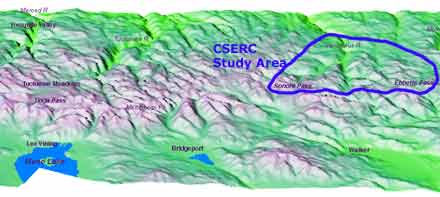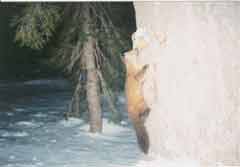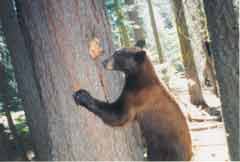Search
for Rare Furbearers Leads CSERC Staff into Remote Corners of the Forest
Andy Hatch
Biologist, Central Sierra Environmental
Resource Center
John Buckley
Director, CSERC
"It's a tough job, but somebody has to do it" is an old joke among
wildlife biologists who get to spend all their field time in the wilderness.
But it's true. I work as a biologist for the Central Sierra Environmental
Resource Center (CSERC). Along with other CSERC staff, I spend much of the
year searching for rare wildlife species by hiking, skiing, or snowshoeing
deep into wild, old-growth forest habitat areas of the Stanislaus National
Forest where we set up infrared-triggered photo-detection stations.
Along the western and northern boundaries of Yosemite National Park, the Stanislaus National Forest stretches across roughly 900,000 acres. From the oak woodlands and deep river canyons of the foothills all the way up to Ebbetts Pass and Sonora Pass at the crest of the range, the Stanislaus Forest provides a home to 350 species of wildlife.
 |
| CSERC study
area, viewed from east of the Sierra crest. Yosemite National Park is
left of the study area (click to enlarge). Adapted from map produced by Gordon Ye, UC Berkeley AEGIS Laboratory, All rights reserved. |
Some of these species have declined dramatically in recent years. Certain amphibians, the Willow Flycatcher (Empidonax traillii), and a number of furbearers lead the list of threatened or "at-risk" species. The wolverine (Gulo gulo), the Sierra Nevada red fox (Vulpes vulpes), the Pacific fisher (Martes pennanti), and the American marten (Martes americana) are four furbearers that are either rare, extremely rare, or possibly extirpated from this central region of the Sierra Nevada. These are the animals that CSERC staff aim to find with our photo-detection surveys.
CSERC's Programs
For the past three years CSERC's director, John Buckley, has worked alongside
staff biologists to set up Trailmaster photo-detection equipment in order
to take pictures of wildlife attracted to baits and attractants. The main
bait used has been store-bought chicken wired high up on a tree carefully
selected to be perfectly aligned between two other trees. On the outside trees,
a transmitter and receiver are carefully attached with bungee cords and set
so that an infrared-triggered beam cuts right below the chicken bait. When
a visiting animal climbs the tree to chew on the chicken, it breaks the beam
and activates an attached camera system that then photographs the animal.
The main purpose of our work is to prove where rare furbearers are still surviving within the boundaries of the National Forest lands. Logging, road-building, and development on Forest Service lands has dramatically changed much of the habitat that once provided homes for abundant populations of fisher, marten, and the Sierra Nevada red fox. Another extremely rare furbearer, the wolverine, may have never been at high population levels – even before human disturbance – due to habitat limitations and rugged terrain of the upper elevation mountains where wolverines were historically found.
CSERC staff are doing these wildlife surveys as part of a cooperative effort with the Stanislaus National Forest. The Forest Service has provided the use of some of its Trailmaster equipment along with the consultation of one of its biologists. CSERC provides all the staff time to do the extensive, time-consuming fieldwork. The Center also pays for the replacement and repair of damaged equipment (see below).
Challenging
Work in Remote, Wild Conditions
A typical day setting-up or monitoring photo-detection equipment usually starts
the night before: testing equipment, replacing batteries, buying bait at the
store, etc. By the time all of the Trailmaster equipment, bait, water, notebooks,
extra warm clothes, and food are loaded into a backpack, it can weigh around
30 pounds. With this load, CSERC staff head out into the forest, avoiding
trails and roads whenever possible. In summer months, this means bushwhacking,
scrambling, and forging a path into remote areas miles from the nearest road
or trail. In the winter, skiing is the easiest method for getting into remote
old-growth forest patches. A good sense of direction is probably the most
important factor in the fieldwork. While the locations of each station are
mapped, returning to an exact tree in the middle of a forest can occasionally
be very difficult. With the summer roads that get us near these stations closed
by snow, it is often necessary to traverse miles of canyon, ridges, or peaks
to get back to those same trees in winter.
Once arriving at a given site, notes are taken, data is recorded, and new film, bait, and lure are added to the site. Because the equipment has to be placed in trees to function, the threat of dripping branches and "snow bonkers" becomes a reality and staff are often soaked before the station is fully functioning and ready for action. Stations are placed at least a half-mile apart so once one station is up and running, a hike begins to the next location. While the hikes are beautiful and rewarding, they are often difficult. Streams must be carefully crossed over weak snow bridges; talus slopes ascended; and dense forest navigated to move from one station to another. When conditions are favorable, monitoring the stations can't be beat, but when the conditions are against you, it can make for an extremely long day.
Kinds of Species
Detected
 |
| Marten (Martes
Americana) at bait station. CSERC photo |
CSERC has had mixed results over the past four years. While American marten has been detected at a number of different locations, other target species have not. A number of different forest carnivores have been photographed, and a wide range of other species has been detected as well. During the fall of 2001 the following species were detected: American marten, Black Bear, Coyote, Gray Fox, Spotted Skunk, Bobcat, Flying Squirrel, Douglas Squirrel, Golden-Mantled Ground Squirrel, and Nuthatch. This is only a partial list of species the CSERC has detected, and with any luck we will be added more species to the list each year research is conducted.
Curious Bears,
Munched Equipment
 |
| The ubiquitous
Black Bear (Ursus americanus) checking the chicken. CSERC photo |
As expected, Black Bear (Ursus americanus) seem to be one of the primary visitors to the stations, except during the dead of winter when they are not active. This means that our equipment is constantly at risk of being the unfortunate recipient of bear curiosity or malice. The camera flashing at a bear during the middle of the night while the bear is enjoying a nice meal of raw chicken and "gusto" (the lure we use), seems to annoy the bears. Often, the equipment suffers as a result. Even a happy but curious bear may chew the camera cable or munch a bit on the Trailmaster units, causing hundreds of dollars of damage. It is not uncommon to see a couple of pictures of a bear on a roll of film, then the camera will have been knocked out of place and all we get is pictures of the ground or sky, and a mess of equipment. At one station this fall, a bear literally broke all of the equipment at the site. We found the transmitter and receiver strewn about the forest floor covered with telltale claw and tooth marks. Avoiding the bears is really only possible in the middle of winter, but some precautions can be taken during the summer. Stations are placed higher up in large diameter trees in hopes that the bear will have difficulty reaching the bait. While this has worked on occasion, bears are pretty smart and agile, and chances are that if a human can get the bait, so can a bear.
Fishers, Sierra Nevada Red Fox, and Wolverine Still Undetected
 |
| Wolverine (Gulo gulo). There are still sightings in the southern Sierra, but none have yet been detected in the CSERC study. |
One of CSERC's main goals has been the documentation of rare and reclusive forest carnivores – particularly American marten, Fisher, Sierra Nevada red fox, and Wolverine. Of these species, we've only been able to confirm the presence of the American marten. There are a couple of deductions that might be drawn from this information. The first is that those species not detected have been extirpated from the Central Sierra as a result of habitat fragmentation and degradation. A second possibility is that we have just been unable to locate these rare species with the equipment and techniques we are currently using. While the second is a possibility, chances are that if these species were still able to exist in the fragmented habitats of the Central Sierra, CSERC would find them. Either way, management decisions should reflect the needs of these species even though they are not currently detected, only then can we ensure their survival or eventual recovery.
Our Founder Questions? Go to About Our New Site |
Masthead
Photo from: |